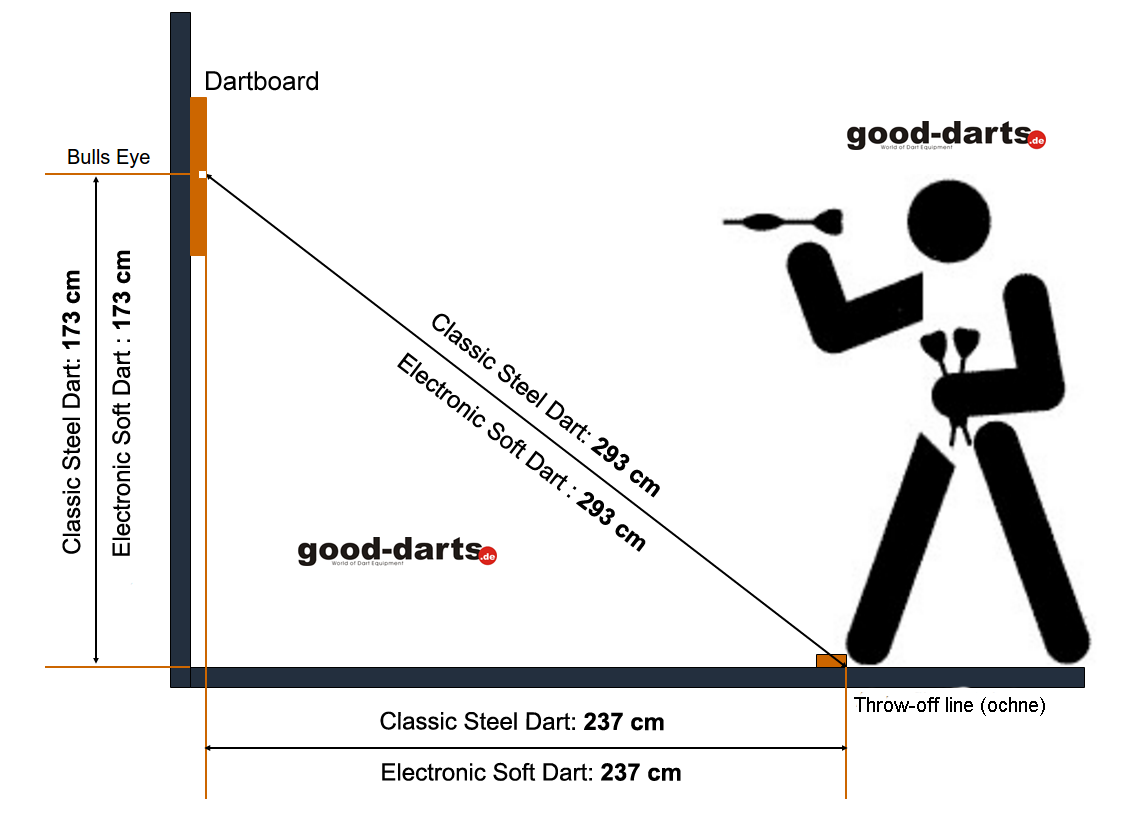Darts Regulation Height And Distance
When it comes to playing darts, one of the most important aspects is ensuring that the dartboard is set up at the correct height and distance. This is essential to maintain fairness and accuracy in the game. In this article, we will delve into the regulations regarding the height and distance of a dartboard, as well as provide you with some helpful tips and tricks to improve your darts gameplay.
The Perfect Dartboard Height

One of the first steps in setting up your dartboard is ensuring it is at the correct height. According to the official regulations, the center of the bullseye should be positioned exactly 5 feet 8 inches, or 1.73 meters, above the ground. This height ensures that the dartboard is at the optimal level for players to aim at the target with ease.
It is important to note that when measuring the height, you should consider the floor distance. This means that the actual distance from the floor to the center of the bullseye might be slightly different due to variations in flooring or wall thickness. However, as long as the center of the bullseye is at the prescribed height, you can consider it as being correctly set up.
The Ideal Throwing Distance
In addition to the height, it is crucial to position yourself at the correct distance from the dartboard for a fair and competitive game. The regulation throwing distance is measured from the front of the board, known as the oche, to the toe line, where the player stands.
The standard throwing distance, commonly used in both professional and recreational games, is 7 feet 9 1/4 inches, or 2.37 meters. This distance is measured horizontally from the face of the dartboard to the toe line, following an imaginary line.
Tips for Accurate Dart Throwing
Now that you understand the regulations regarding the height and distance of a dartboard, let's explore some tips and tricks to help you improve your dart throwing skills:
- Focus on Your Stance: Maintaining a balanced and stable stance is crucial for accurate dart throwing. Stand with your feet shoulder-width apart and distribute your weight evenly.
- Hold the Dart Correctly: Grip the dart with a relaxed and comfortable grip. Aim to hold it between your thumb and forefinger, finding a grip that feels natural to you.
- Aim for Consistency: Develop a consistent throwing technique. Practice your throw repeatedly to develop muscle memory, allowing you to throw consistently each time.
- Follow Through: Focus on a smooth follow-through when releasing the dart. This will help maintain a straight and accurate trajectory.
- Practice Your Focus: Concentrate on the target and block out any distractions. Keep your eyes fixed on the segment you want to hit, and visualize your dart hitting the target.
Common FAQs About Darts
Here are answers to some frequently asked questions about playing darts:
1. What are the different dartboard segments?
The dartboard is divided into several numbered segments, as well as specific targets such as the bullseye. The segments on a standard dartboard are numbered from 1 to 20, with each number allocated a different point value.
2. Can you explain the scoring system in darts?
Each segment on the dartboard has a different point value. Hitting a segment within the outer ring earns you double the points, while hitting the inner ring will give you triple the points. The bullseye, located at the center of the board, is worth the highest points.
3. Can I play darts for recreational purposes?
Of course! Darts is a versatile game and can be enjoyed by people of all skill levels. Whether you're playing with friends at a pub or in the comfort of your own home, darts is a fun and entertaining game that can provide hours of excitement.
Conclusion
Setting up your dartboard at the correct height and distance is crucial to ensure a fair and competitive game. By adhering to the regulations and following the tips provided, you can enhance your dart throwing skills and enjoy the game to the fullest. Remember to practice regularly and have fun!
Latest Regulation: Dartboard Regulation Height And Distance
dartboard darts cabinet regulation diameter surround bauen printyourbrackets dardo jogo swick selber backboard heights 1727 idées plein décoration partyraum dardos
Standard Volleyball Pole Height | Volleyball Games
 Image Source : voleyball-games.blogspot.com
Image Source : voleyball-games.blogspot.com darts throwing dart dartboard dimensionsguide dartboards
Dart Board Rules | Dart Board Wall, Darts, Dart Board
 Image Source : www.pinterest.com
Image Source : www.pinterest.com dart darts dartboard regulations
Dart Regulations - Official Height, Distance, And More
 Image Source : gameroomvault.com
Image Source : gameroomvault.com darts dartboard cricket dartboards dardos cabinet scoring darten
22 What Is The Regulation Height Of A Dartboard Full Guide
 Image Source : pgdtaygiang.edu.vn
Image Source : pgdtaygiang.edu.vn The Ultimate Darts Rules Guide: 10 Popular Games & How To Play Them!
 Image Source : dartsadvice.com
Image Source : dartsadvice.com dartboard height distance regulation measurements dart darts board rules distances diagram games play game regulations line throw throwing official setup
Regulation Dart Distance Sales Cheap, Save 69% | Jlcatj.gob.mx
 Image Source : www.jlcatj.gob.mx
Image Source : www.jlcatj.gob.mx Pin By Adam Belanger On Stuff | Hanging A Dart Board, Dart Board Wall
 Image Source : www.pinterest.com
Image Source : www.pinterest.com darts dartboard distance cork basement remodeling billiard
Standard volleyball pole height. 22 what is the regulation height of a dartboard full guide. Regulation dart distance sales cheap, save 69%. Dartboard darts cabinet regulation diameter surround bauen printyourbrackets dardo jogo swick selber backboard heights 1727 idées plein décoration partyraum dardos. Dart darts dartboard regulations